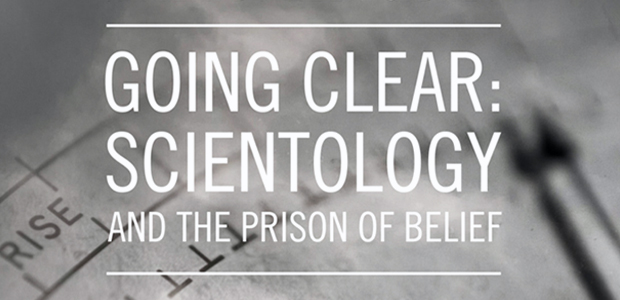Academy Award winner Alex Gibney directs the documentary Going Clear: Scientology and the Prison of Belief. Based on the Lawrence Wright book of the same name, with testimonials from ex high ranking members, the film charts the history of this controversial organisation.
From its founder L. Ron Hubbard, its origins in Dianetics, to its celebrity appeal and ongoing controversy, Going Clear presents a concise history of The Church of Scientology, and what allegedly goes on behind the scenes.
Watching a documentary can be a precarious thing. In many ways it’s similar to reading a newspaper. Do you read a newspaper to learn what’s going on in the world? Or do you read a newspaper for their columnist section to re-inforce the beliefs you already hold?
Documentaries pose a similar problem, especially when it comes to controversial subjects such as Scientology. Notwithstanding the prejudices the viewer may or may not already have, the agenda of the documentarian must also be taken into account. Having been moved by Gibney’s previous work ‘Mea Maxima Culpa: Silence in the House of God’ I was confident he would approach the subject of Scientology with the same rigour.
The film is also given credence thanks to its interviewees. Oscar-winning director Paul Haggis, Scientology’s former second-in-command Mark Rathbun, former head of the Office of Special Affairs Mike Rinder as well as former members Tom DeVocht, Sara Goldberg, Hana Eltringham Whitfield and Sylvia ‘Spanky’ Taylor, former friend to John Travolta.
The film starts with L. Ron Hubbard. It recalls his time in the navy, his record of being the world’s most published and most translated author and then moves onto the organisation he founded, The Church of Scientology. Whether it was down to the lack of sources or friends willing to speak openly the film doesn’t delve too deeply into Hubbard’s personality or motives. Ultimately the man is portrayed to be a fanciful figure, who, spurned by the psychiatric community, sets out to create his own religion.
Another factor addressed in the film is the organisation’s determination to be recognised as a tax-exempt religious and charitable organization. This mission began with Hubbard and was fulfilled by his predecessor David Miscavige. The Roman Catholic Church is a religion that is worth billions, but the leaders of The Church of Scientology are presented as having an unhealthy fixation with taxation and money.
The film also focuses on the celebrities that have been drawn to the organisation. John Travolta is presented as an insecure young actor who at the beginning of his career leaned heavily on the organisation, then later on wanted to leave, but was unable to do due to the organisations ‘Auditing’ sessions having damaging information on him. Inversely, Tom Cruise is presented as being a true believer, who was wooed by Miscavige, by indulging the actor’s every whim, so he could create the ultimate poster boy for the organisation.
Ultimately the meat of the film comes from the former high ranking members. The testimonies from Mark Rathbun, Mike Rinder and Sylvia ‘Spanky’ Taylor, if believed, are simply harrowing. With stories of babies being covered in fruit flies or members being detained and beaten the film presents the organisation as secretive, controlling and brutal.
The film also states that the organisation is unable to be held accountable for these alleged crimes due to its current tax status, making it possible for them to deflect these accusations with The First Amendment. The film claims the IRS granted the organisation religious status in order to rid themselves of the numerous lawsuits The Church of Scientology threw at them. The curious fact that an agency responsible for tax collection is also responsible for determining whether an organisation is a religion or not, is not lost in the film. This ultimately leads to the fundamental question at the heart of the film.
What is the difference between a religion and cult?
The belief in the fanciful, however well-meaning or otherwise, makes making that distinction a difficult one to define, especially for atheists. A possible answer is given in the movie. According to the film is you ask a practicing Jew, Christian or Muslim what exactly it is that they believe most believers will be able to explain the fundamentals to you in a couple of minutes. According to the film however, if you ask a practicing member of The Church of Scientology what exactly is it that they believe they’ll probably be able to explain it to you in about seven years, after having spent thousands of pounds and eventually being told a story about the galactic ruler Lord Xenu, which they are not allowed to tell anyone else about.
The film ends with the belief that The Church of Scientology is cult, and a brutal one at that, and as long as it is able to hide behind it’s tax religious status, and as long as its high profile celebrity members turn a blind eye, the abuse will continue.
Check out ‘Going Clear: Scientology and the Prison of Belief’ and see what you believe.
Enjoy this article? Then why not sign up to Fortitude Magazine’s Weekly Round Up! Our pick of the week’s best news, reviews, videos and music straight to your inbox. Sign up today!

